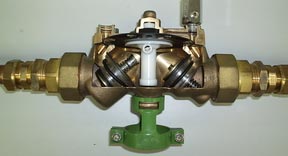Backflow Prevention
What is Backflow prevention?
Backflow prevention is the term used to refer to the prevention of an unwanted reverse flow of water from a potentially polluted source into the drinking water supply. This reduces the risk of any contamination from a property flowing back through connections to the water supply system.
When does backflow occur?
Backflow occurs because a condition exists in a water supply system that will cause back-siphonage or back-pressure. Back-siphonage can occur on a property through a vacuum created in the water supply system.
An example of back-siphonage would be a pipeline breakage, undersized pipework or high withdrawal rates. Back-pressure can occur within properties when high pressure is generated downstream by pumps, thermal expansion or elevation, broken water mains or when any water service is turned off and drained.
Backflow prevention starts within a property boundary by isolating a possible contamination source from the town mains or storage tanks (rainwater tanks) from the tap or appliance.
Who can install a backflow device?
Only licensed plumbers can install a backflow prevention containment device.
Only licensed plumbers with backflow prevention accreditation issued by a registered training organisation can inspect, commission and test backflow devices.
Before you install a backflow prevention device, you should check the available water pressure and the customer’s pressure and flow requirements. A site assessment should also be done to confirm the hazard rating of the property and its services.
Applications
A backflow incident can cause health concerns for people using your water. A backflow prevention containment device ensures that when there is a cross connection the drinking water supply cannot be contaminated. There are different types of devices which can be installed depending on the hazard rating of the property. The three hazard ratings identified AS/NZS 3500:1 Section 4 are:
- High hazard – any condition, device or practice which in connection with the water supply system has the potential to cause death
- Medium hazard – any condition, device or practice which in connection with the water supply could endanger health
- Low hazard – any condition, device or practice which in connection with the water supply system would constitute a nuisance but not endanger health
- Depending on what type of hazard suits your application, depends on the type of device being installed
Examples of potential source of contamination:
- Fire Hose Reels (FHR)
- Irrigation
- Swimming pools
- Vehicle maintenance pits
- Ornamental ponds
- Air conditioning towers
- Vehicle/bin washing bays
- Chemical injection areas
Examples of properties requiring backflow prevention:
- Motels and unit complexes
- Hotels
- Vehicle repair workshops
- Shops
- Restaurants
- Caravan parks
- Medical and dental surgeries
- Car and plant washing facilities
- Dry cleaners and laundries
- Hospitals and funeral parlours
- Club houses for sports
- Schools
- Day care centres and kindergartens
- Pest control and water carrying vehicles
- Botanic gardens











